
San Giorgio in Poggiale is a Baroque-style, deconsecrated, former Roman Catholic church, now serving as the Art and History Library of Fondazione Carisbo (the former owner of Carisbo), located on Via Nazario Sauro 20 in central Bologna, Italy.

San Giorgio in Poggiale is a Baroque-style, deconsecrated, former Roman Catholic church, now serving as the Art and History Library of Fondazione Carisbo (the former owner of Carisbo), located on Via Nazario Sauro 20 in central Bologna, Italy.
A church on the site had been present since the Lombard era, but the present layout was designed by the architect Tommaso Martelli, and built between 1589 and 1633. The initial custodians of the church were priests of the Servite order. In 1798, the church and adjacent convent was suppressed by the Napoleonic Government. Till 1919, the street in front was known as Via del Poggiale. The Bell-tower was built between 1760 and 1763. With the restoration of the Duchy, the church was assigned to Franciscan Order till 1842, then to the Jesuits in 1882. It was partially destroyed during an aerial bombardment on September 25, 1943. [1]
Nearly destroyed in the decades after the war, the building was acquired by the Fondazione Cassa di Risparmio in Bologna, and they commissioned a reconstruction by architect Michele De Lucchi. The modern library was opened in 2009. The reading room houses works by Claudio Parmiggiani as well as Piero Pizzi Cannella’s Cattedrali cycle. [2]
The church lacks all it internal painted decoration. The nave was once frescoed with the Fasti di San Pietro Celestino by Giacomo Boni and Giacinto Garofalini. The quadratura was painted by Luca Antonio Bistega. The chapels had altarpieces by Lucio Massari (la Maddalena), Anna Maria Crescimbeni, Marcantonio Franceschini, Emilio Taruffi, Enrico Haffner, Grilli, Giovanni Battista Bertusio and il Mastelletta. The sacristy and decoration was designed by Francesco Tadolini with stucco-work by Petronio Tadolini, Antonio Gamberini, and Martino Bagutti. [3]
Luciano Pavarotti recorded Passione (Neapolitan Songs) in this space July 22–31, 1985.[ citation needed ]
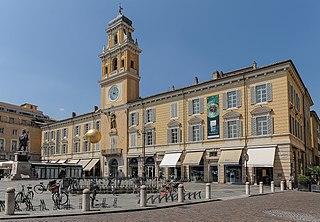
Parma is a city in the northern Italian region of Emilia-Romagna known for its architecture, music, art, prosciutto (ham), cheese and surrounding countryside. With a population of 198,292 inhabitants, Parma is the second most populous city in Emilia-Romagna after Bologna, the region's capital. The city is home to the University of Parma, one of the oldest universities in the world. Parma is divided into two parts by the stream of the same name. The district on the west side of the river is Oltretorrente. Parma's Etruscan name was adapted by Romans to describe the round shield called Parma.
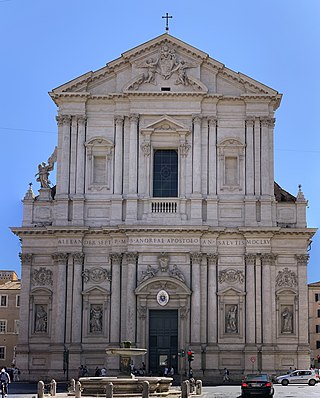
Sant'Andrea della Valle is a minor basilica in the rione of Sant'Eustachio of the city of Rome, Italy. The basilica is the general seat for the religious order of the Theatines. It is located at Piazza Vidoni, at the intersection of Corso Vittorio Emanuele and Corso Rinascimento.

The Basilica of San Petronio is a minor basilica and church of the Archdiocese of Bologna located in Bologna, Emilia Romagna, northern Italy. It dominates Piazza Maggiore. The basilica is dedicated to the patron saint of the city, Saint Petronius, who was the bishop of Bologna in the fifth century. Construction began in 1390 and its main facade has remained unfinished since. The building was transferred from the city to the diocese in 1929; the basilica was finally consecrated in 1954. It has been the seat of the relics of Bologna's patron saint only since 2000; until then they were preserved in the Santo Stefano church of Bologna.

Santa Maria dei Miracoli and Santa Maria di Montesanto are two churches in Rome.

The Basilica of San Domenico is one of the major churches in Bologna, Italy. The remains of Saint Dominic, founder of the Order of Preachers (Dominicans), are buried inside the exquisite shrine Arca di San Domenico, made by Nicola Pisano and his workshop, Arnolfo di Cambio and with later additions by Niccolò dell'Arca and the young Michelangelo.

The Galli–Bibiena family, or Galli da Bibiena, was a family of Italian artists of the 17th and 18th centuries, including:

San Paolo Maggiore is a basilica church in Naples, southern Italy, and the burial place of Saint Cajetan, founder of the Theatines. It is located on Piazza Gaetano, about 1-2 blocks north of Via dei Tribunali.

The Basilica of San Giacomo Maggiore is an historic Roman Catholic church in Bologna, region of Emilia Romagna, Italy, serving a monastery of Augustinian friars. It was built starting in 1267 and houses, among the rest, the Bentivoglio Chapel, featuring numerous Renaissance artworks.
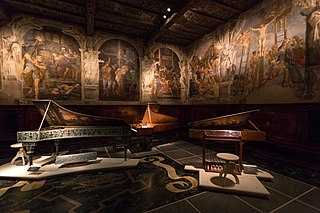
The Oratory of the Madonna of San Colombano, also called the Chiese di San Colombano e Santa Maria dell'Orazione is a religious site in central Bologna, found on Via Parigi #5, near the Bologna Cathedral.

The Oratory of San Filippo Neri in Bologna is a restored late-Baroque religious structure in central Bologna. It is located on Via Manzoni. The Oratory was constructed from the sacristy of the adjacent church of the Madonna di Galliera. This church is now called Chiesa dei Filippini Madonna di Galliera e Filippo Neri.
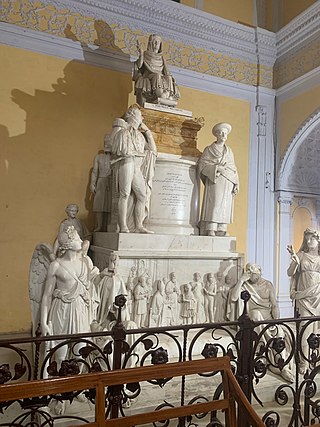
Adamo Tadolini was an Italian sculptor. One of a family of sculptors, he studied in Rome with the neo-classical sculptor Antonio Canova and is linked to him in style.
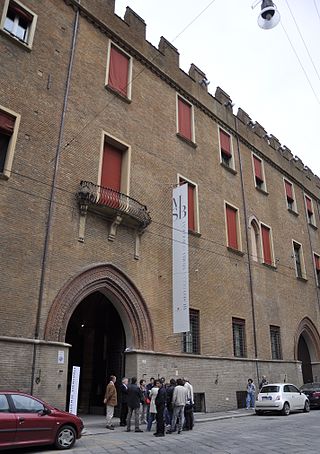
The Palazzo Pepoli Vecchio is a Medieval palace located on Via Castiglione number 8, in central Bologna, region of Emilia-Romagna, Italy. The merlonated brick Gothic-style building is now the civic Museum of the History of Bologna. It stands across the street from the Baroque-style Palazzo Pepoli Campogrande, now a civic art gallery.

The Palazzo Legnani Pizzardi, also known as Palazzo Pizzardi e Volta or just Palazzo Pizzardi, is a Renaissance style palace located on Via d'Azeglio #38, corner with Via Farini, in central Bologna, Italy. In 2015, the palace housed the Tribunal of Bologna.

Palazzo Fava or Palazzo Fava-Ghisilieri is a historic palace at 2 via Manzoni in Bologna, now housing art exhibitions and the Caffè Letterario Carracci Fava. It is most notable for its three rooms of frescoes of scenes from the lives of Jason, Medea, Europa and Aeneas by Ludovico Carracci, Agostino Carracci and Annibale Carracci, commissioned in 1584 by Filippo Fava - he was introduced to them by his tailor Antonio, Agostino and Annibale's father.
The Palazzo Zagnoni, also known as Palazzo Spada, is a Neoclassic-style palace located on Via Castiglione 25–27, in Bologna, region of Emilia-Romagna, Italy.

San Paolo Maggiore, also known as San Paolo Decollato, is a Baroque-style, Roman Catholic basilica church located on Via Carbonari #18 in Bologna, region of Emilia-Romagna, Italy.
Fondazione Cassa di Risparmio in Bologna is a philanthropic organization formed in 1991 by the separating of the bank into a private limited company and a banking foundation. The headquarter of the foundation was right opposite to Palazzo di Residenza della Cassa di Risparmio in Bologna, the headquarter of the bank.
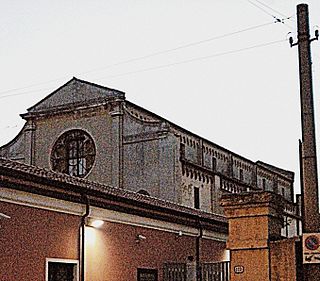
San Giovanni di Verdara or Saint John of Verdara is a former Roman Catholic monastery and church located on Via San Giovanni di Verdara # 123, in the city of Padua, region of Veneto, Italy. It was founded in 1221, but now serves as a military hospital, and is not accessible to the public.
The Teatro Contavalli was an opera house and theatre located at Via Mentana #2, in Bologna, region of Emilia-Romagna, Italy. Long since utilized as a theater, the site is now occupied by offices for the Centro Italiano di Documentazione sulla Cooperazione e L' Economia Sociale.

San Sebastiano was a Roman Catholic church in the historic centre of Verona, Italy dedicated to Saint Sebastian. It was founded as an oratory in the 10th century, and it eventually became a parish church and was rebuilt in the Romanesque style. Between the 16th and 19th centuries, the church intermittently belonged to the Jesuits. They renovated the building in the late 16th and early 17th centuries, but the façade was only completed in 1830.